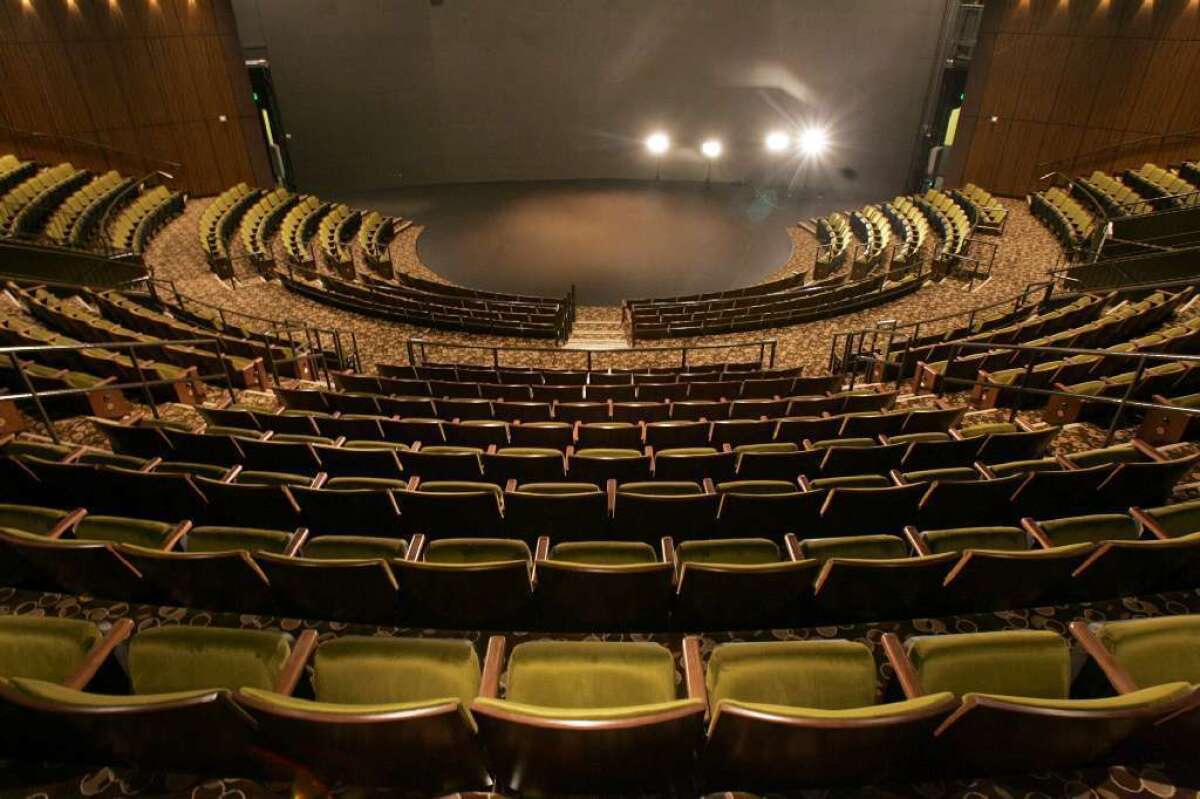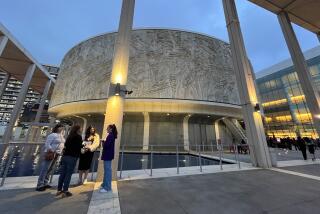Nonprofit theaters are attracting more donors, but audiences keep shrinking, report says

Inside the Mark Taper Forum before the audience arrives. A new study says that the nonprofit theater sector has continued to see its audiences decline in the five years since the Great Recession, although at a slower pace than before and during the downturn.
A survey of nonprofit theaters nationwide shows that they’ve upped their game since the Great Recession when it comes to attracting donors and earning money, but that their audiences have continued to dwindle.
The average theater in the survey spent about $1.2 million and survived without much of a cash backstop, the report by Theater Communications Group found.
It warned that a sheer lack of ready spending money “remains a critical cause for concern and a threat to the future viability of many theaters in the field.”
SIGN UP for the free Essential Arts & Culture newsletter >>
The report, “Theatre Facts 2014,” sifted through survey responses and financial statements for the 2014 fiscal year from 177 theaters that are members of New York-based TCG, a national service organization for nonprofit theaters.
Extrapolating from those responses, TCG came up with estimates on revenues and attendance for all 1,770 professional nonprofit theater companies in the United States that produce their own plays.
Perhaps the most daunting finding was culled from 88 theaters that have shared numbers with TCG every year since 2005. That year their average attendance peaked at about 107,000. Since then there has been a fall-off of 8.7%, an average loss of about 9,000 theatergoers for each company over the nine years.
The theaters responded, in part, by raising ticket prices 29% over that period -- 8% more than they would have needed to keep up with inflation.
The rate of attendance decline at least has slowed since the recession, the study found.
“It’s really pretty remarkable that we haven’t seen attendance drop even more” because of intense and growing competition, especially from online entertainment, TCG’s executive director, Teresa Eyring, said in an interview. “There’s an enormous resiliency in the theater field.”
Theaters are making adjustments by trying new approaches, she said, including more emphasis on shows geared toward children and parents.
The report said that productions for young audiences were “a bright spot” in which attendance grew 12.9% between 2010 and 2014. But childrens’ series accounted for just 3% of total attendance at the 118 theaters surveyed over the five years.
“More theaters would benefit from producing high-quality programming for multigenerational audiences,” Eyring said. “Not only because the numbers tend to be on the rise, but it’s a way of engaging the next generation of theatergoers.”
Donors kept theaters afloat. Contributions to the 118 theaters averaged $3.5 million in 2014, a post-recession high. Giving rose 6.6% over 2013 and and was up 22.7% from 2010.
But will those donors continue to give if attendance keeps falling?
“That’s a complex question,” Eyring said. “Certainly we have to be concerned about attendance,” but she said theaters can cultivate donors for other programs, such as education and community events.
Another problem the report identified is a lack of “working capital,” defined as “readily available funds to meet daily needs.”
It said a “benchmark” for adequate working capital would be reserves equivalent to three months’ operating expenses. Only 9% of theaters met that mark in 2014, the report said, suggesting that “theaters are regularly experiencing cash flow crunches.”
Despite its troubles, the world of nonprofit theater still has a wide reach. Professional nonprofit companies that produce their own shows performed for 32.8 million playgoers nationwide in fiscal 2014, TCG estimates.
That outpaces the draw of Broadway shows in New York and on tour, which sold 26 million tickets combined in the 2013-14 season, according to the Broadway League.
The 32.8 million figure does not include people who see plays mounted by community theaters, which are not considered professional shows, and it largely excludes theater presentations at multipurpose nonprofit performing arts venues such as the Broad Stage in Santa Monica and the Segerstrom Center for the Arts in Costa Mesa, which typically don’t produce the shows they offer.
The worlds of nonprofit theater and Broadway generated virtually the same amount of money in 2014, $2.2 billion each, according to TCG’s estimate and the Broadway League’s tally.
But nonprofit theaters made only about half their money at the box office (and from other fees, such as renting a theater or tuition for theater classes). They counted on donors for 47% of their funds.
Follow @boehmm of the LA Times for arts news and features
ALSO:
Sneak peek at 2016 Hollywood Bowl season, including Lang Lang and Yuja Wang
SFMOMA vs. LACMA? Bruins vs. Trojans? Philanthropy 400 list reveals biggest fundraisers
‘Breaking Through’ shows seamy side of stoking the star-making machinery
More to Read
The biggest entertainment stories
Get our big stories about Hollywood, film, television, music, arts, culture and more right in your inbox as soon as they publish.
You may occasionally receive promotional content from the Los Angeles Times.











